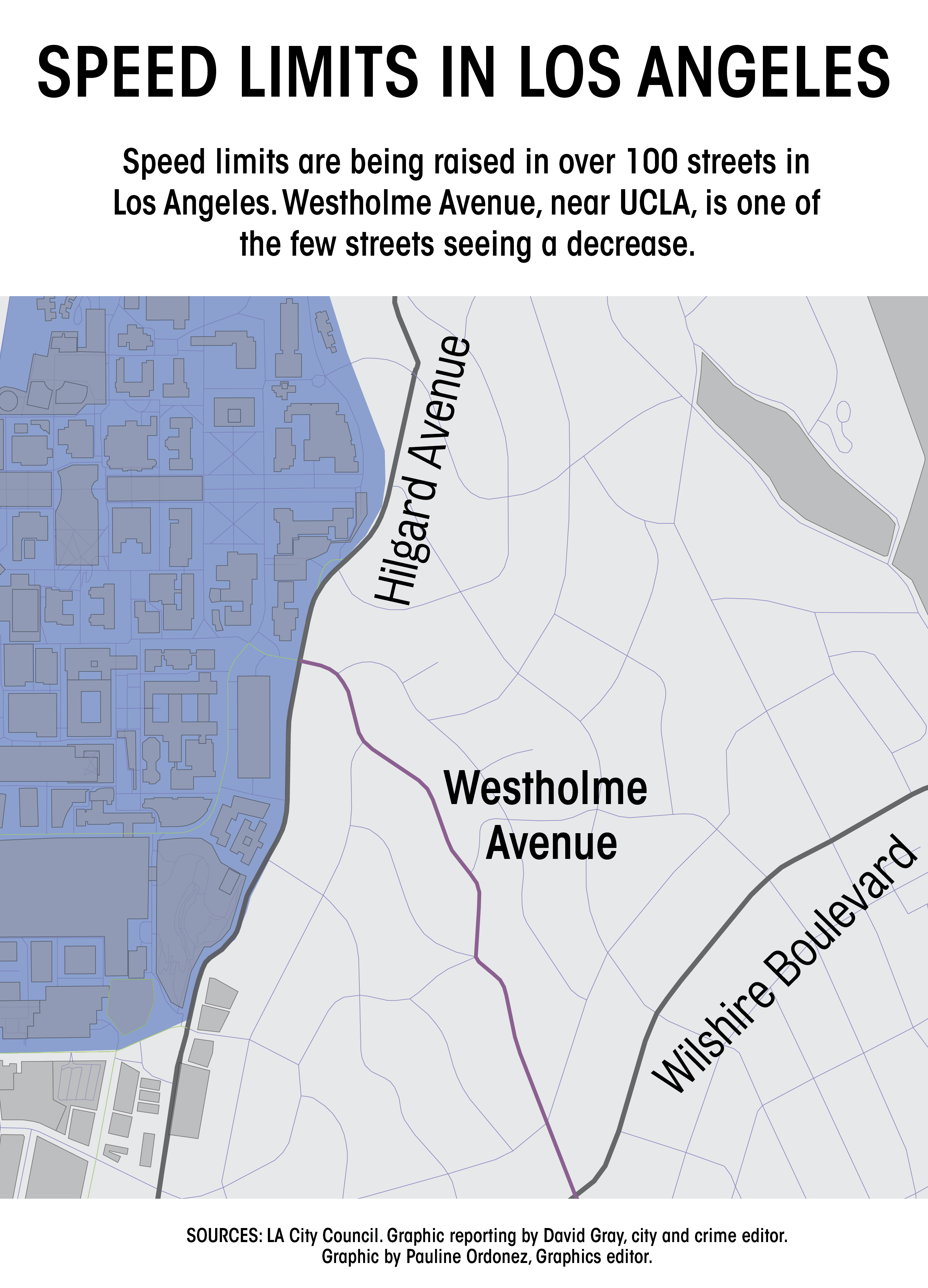City Council changes speed limits to aid traffic law enforcement, improve safety

More than a hundred streets across Los Angeles will have new speed limits starting Sunday.
LA City Council members unanimously voted to raise and lower speed limits for roughly 114 miles of streets in the greater Los Angeles area Dec. 11. City officials adjusted these limits partly to make sure they are still compatible with current traffic patterns. The ordinance will go into effect Jan. 27.
Streets, where police were prohibited from using radar for detecting speeding, will become eligible for radar enforcement after their speed limits increase, according to the LA City Council Transportation Committee report. The introduction of radar enforcement will likely increase police officers’ ability to ticket drivers for traffic infractions, according to the report.
The speed limits for around 102 miles of streets will increase by 5 or more miles per hour. However, the limits for 12 miles of streets, some of which are in the Westwood area, will decrease. The speed limits for the section of Bel Air Road between Rial Lane and Sunset Boulevard, and the section of Bellagio Road between Bel Air Road and Moraga Drive will be lowered from 30 to 25 miles per hour. The section of Westholme Avenue from Hilgard Avenue to Wilshire Boulevard will also be lowered by the same amount.
City Councilmember Paul Koretz, who represents the area including Westwood, said traffic laws intended to prevent speed traps in rural communities were applied to city spaces in LA many years ago, causing an array of unforeseen issues like having to increase speed limits to ensure law enforcement can detect speeding infractions.
“Our big problem is legislation at the state that was passed a number of years ago to deal with rural speed traps,” he said.
Koretz added the speed limits should be changed to match the current speeds of drivers.
“So what the law says is you have to base your current speed limit on roughly what people are driving now,” Koretz said. “What that means is if you haven’t done a speed survey of what people are driving now and raise the limit (to) nowhere (near) that existing speed, you can’t enforce and you can’t use radar.”
Koretz said this puts council members in a somewhat awkward position, as they have to raise speed limits to enforce traffic regulations for speeding.
“Ultimately, what I think happens is you raise the speed limit, people go a little bit over the new speed limit and then you do another rating a while later and you move the speed limit up higher,” he said.
Cynthia Mendoza, a third-year history student who commutes from San Gabriel, said she is concerned that raising speed limits would potentially endanger more pedestrians.
“I’ve seen some scary close calls with pedestrians. So raising the speed limit even 5 miles per hour, I’m sure drivers are going to take advantage of that,” Mendoza said. “That might make the difference between them being able to stop or those just being close calls, or not.”
Chloe DeRoon, a third-year psychology student, said she had mixed thoughts on the change.
“I guess outside of rush hour and traffic times, I’d be okay with the new speed limit because I have kind of a need for speed,” DeRoon said.
Koretz said he was also concerned about the increased speed limits’ possible effects on pedestrian safety.
“It’s all hard to say; I mean, the faster you drive the more likely a pedestrian fatality is to occur. If we raise the speed limit, it’s to be able to enforce and use radar and give tickets for speeding,” Koretz said. “It will reduce the number of people that go far above the speed limit, but it may also increase the average speed in the area.”
University police Lt. Kevin Kilgore said he supported lowering the speed limits for some of the streets in Westwood because he thinks it will make streets safer for pedestrians.
“In some of the cases, the speed is being lowered and I think that’s a good thing, especially on Westholme Avenue between Hilgard and Wilshire … because that’s a high residential area with a lot of pedestrian traffic with people walking to and from different businesses and UCLA from their homes on the east side of campus,” he said.
Kilgore also said he was uncertain whether the changes would increase the number of tickets issued in Westwood.
“I don’t think you’re going to see much of a change anyway. We don’t have a great area that speeding can be assessed here around campus. Five miles per hour of a change does not make a significant difference to an officer who’s writing a ticket,” he said.
However, Andrew Thomas, executive director of the Westwood Village Improvement Association, said he thinks the changes will effectively increase the number of tickets issued and thus revenue for the city.
“I think the consequences will be the same for students and nonstudents alike. More tickets will be issued,” he said. “The only difference will be in the capacity for students to pay the tickets.”
UCLA faculty members said they think the city should adjust street design and structure as well rather than just speed limits.
Walter Okitsu, a lecturer of civil and environmental engineering, said he thinks traffic engineers should design roads to promote slower driving before speed limits are reduced.
“Traffic engineers look to solve speeding problems by designing streets so that motorists are less enticed to drive at high speeds,” Okitsu said. “After speed-reduction modifications are applied to the roadway, the posted speed limits could be lowered if the next speed survey showed motorists driving slower.”
Ryan Snyder, a lecturer of urban planning and member of the North Westwood Neighborhood Council, said the way that streets are designed has much more influence on traffic speed than speed limit regulations.
“The type of investments I would like to see in Westwood Village are things like more bicycle lanes, for example. They narrow the field of streets and provide some level of space for people to ride their bicycles as well,” Snyder said. “Things like extending curves out and making crosswalks with more visible margins are also helpful.”
Snyder said he thinks curvature extension and increased pedestrian visibility in Westwood Village would effectively help reduce speed limits in the future.
“So when we extend the curves out, pedestrians are crossing the streets in a much more visible location, but it also turns to slow the cars down, especially in a place like Westwood Village where there are many people walking,” he added.
Thomas said he thinks drivers should follow the speed limits to keep others safe.
“My advice for all commuters is to obey the laws of the road. Driving a vehicle is a great responsibility,” he added. “The laws exist for a reason. Obey them so people in other cars, on bikes, on scooters and on foot can all be safe.”



